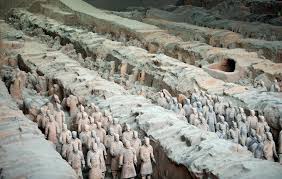
Have the Terracotta Warriors Been Fully Excavated?
The Terracotta Army and Qin Shi Huang's Mausoleum
The Terracotta Army is one of the most iconic archaeological discoveries of all time, captivating the world with its sheer scale and intricately crafted figures. Located near Xi'an, China, this vast army of life-sized terracotta soldiers, horses, and chariots was buried alongside Qin Shi Huang, the first emperor of China, to protect him in the afterlife.
While the three pits containing the Terracotta Army have been extensively excavated, revealing thousands of awe-inspiring figures, the same cannot be said for the entirety of Qin Shi Huang's mausoleum complex. The mausoleum itself, an enormous underground city, remains largely untouched.
The Unexcavated Heart of the Mausoleum
The heart of the mausoleum complex is the massive burial mound, situated southwest of the inner city walls. This earthen pyramid, oriented along an east-west axis, is where Qin Shi Huang's tomb chamber, containing his coffin and burial treasures, is located.
Reasons for Non-Excavation:
- Respect for the Deceased: Chinese tradition places significant emphasis on respecting the dead and their resting places. Disturbing a tomb, particularly one of such historical significance, is a sensitive issue.
- Technological Challenges: The tomb chamber is believed to be located deep beneath the burial mound, potentially booby-trapped with sophisticated ancient mechanisms. Current archaeological technology may not be advanced enough to safely and effectively excavate the site without risking damage to the artifacts within.
- Preservation Concerns: Excavating the tomb chamber exposes the artifacts inside to potential deterioration caused by changes in humidity, temperature, and light exposure. Archaeologists are keen on developing improved preservation techniques before undertaking such a delicate operation.
Ongoing Research and Exploration
While the main tomb chamber remains unexcavated, archaeologists continue to explore and analyze the vast area surrounding it. This includes studying the layout of the mausoleum complex, uncovering smaller tombs and sacrificial pits, and analyzing artifacts to gain a deeper understanding of Qin Dynasty culture, technology, and burial practices.
Through these ongoing efforts, archaeologists and historians hope to piece together a more complete picture of Qin Shi Huang's reign and the construction of his magnificent, enigmatic mausoleum.
FAQs
Q: When will the main tomb of Qin Shi Huang be excavated?
A: There is no definitive timeline for the excavation of the main tomb. The decision to excavate will be carefully considered based on technological advancements, preservation capabilities, and ethical considerations.
Q: Is it possible to visit the unexcavated areas of the mausoleum?
A: No, the unexcavated areas of the mausoleum, including the burial mound, are not open to the public. Visitors can explore the excavated Terracotta Army pits and the surrounding museum, which offer a glimpse into the grandeur of the entire complex.
Q: What are archaeologists expecting to find inside the main tomb?
A: Historical accounts and preliminary surveys suggest that the tomb chamber may contain a wealth of treasures, including valuable artifacts, precious metals, jade objects, silk textiles, and potentially even maps and texts that could shed further light on the Qin Dynasty.